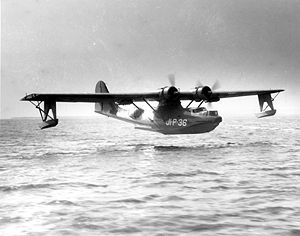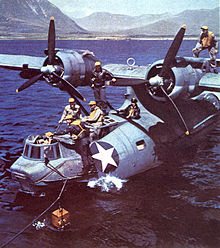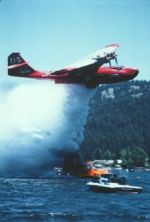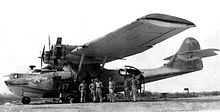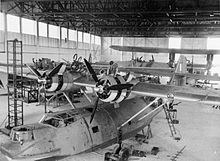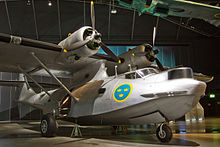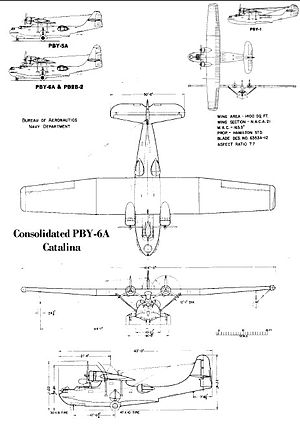- Consolidated PBY Catalina
-
PBY Catalina PBY-5 landing at Naval Air Station Jacksonville. Role Flying boat Manufacturer Consolidated Aircraft Designer Isaac M. Laddon First flight 28 March 1935 Introduction October 1936, United States Navy Retired January 1957, United States Navy Reserve Primary users United States Navy
United States Army Air Forces
Royal Air Force
Royal Canadian Air Force
Royal Australian Air ForceProduced 1936–1945 Number built 4,051 (estimated) Unit cost US$90,000 (as of 1935) Variants Bird Innovator The Consolidated PBY Catalina was an American flying boat of the 1930s and 1940s produced by Consolidated Aircraft. It was one of the most widely used multi-role aircraft of World War II. PBYs served with every branch of the United States Armed Forces and in the air forces and navies of many other nations. In the United States Army Air Forces and later in the United States Air Force their designation was OA-10. A Canadian-built PBY would be familiarly called a Canso.
During World War II, PBYs were used in anti-submarine warfare, patrol bombing, convoy escorts, search and rescue missions (especially air-sea rescue), and cargo transport. The PBY was the most successful aircraft of its kind; no other flying boat was produced in greater numbers. The last active military PBYs were not retired from service until the 1980s. Even today, over 70 years after its first flight, the aircraft continues to fly as an airtanker in aerial firefighting operations all over the world.
The initialism of "P.B.Y." was determined in accordance with the U.S. Navy aircraft designation system of 1922; PB representing "Patrol Bomber" and Y being the code used for the aircraft's manufacturer, Consolidated Aircraft.
Contents
Design
Background
The PBY was originally designed to be a patrol bomber, an aircraft with a long operational range intended to locate and attack enemy transport ships at sea in order to compromise enemy supply lines. With a mind to a potential conflict in the Pacific Ocean, where troops would require resupply over great distances, the U.S. Navy in the 1930s invested millions of dollars in developing long-range flying boats for this purpose. Flying boats had the advantage of not requiring runways, in effect having the entire ocean available. Several different flying boats were adopted by the Navy, but the PBY was the most widely used and produced.
Although slow and ungainly, PBYs distinguished themselves in World War II as exceptionally reliable. Allied armed forces used them successfully in a wide variety of roles that the aircraft was never intended for. They are remembered by many veterans of the war for their role in rescuing downed airmen, in which they saved the lives of thousands of aircrew downed over water. PBY airmen called their aircraft the "cat" on combat missions and "Dumbo" in air-sea rescue service.[1]
Development
As American dominance in the Pacific Ocean began to face competition from Japan in the 1930s, the U.S. Navy contracted Consolidated Aircraft and Douglas Aircraft Corporation in October 1933 to build competing prototypes for a patrol flying boat.[2] Naval doctrine of the 1930s and 1940s used flying boats in a wide variety of roles that today are handled by multiple special-purpose aircraft. The U.S. Navy had adopted the Consolidated P2Y and Martin P3M models for this role in 1931, but both aircraft proved to be underpowered and hampered by short ranges and low maximum payloads.
Consolidated and Douglas both delivered single prototypes of their designs, the XP3Y-1 and XP3D-1, respectively. Consolidated's XP3Y-1 was an evolution of the XPY-1 design that had originally competed unsuccessfully for the P3M contract two years earlier and of the XP2Y design that the Navy had authorized for a limited production run. Although the Douglas aircraft was a good design, the Navy opted for Consolidated's because the projected cost was only $90,000 per aircraft.
Consolidated's XP3Y-1 design (company Model 28) was revolutionary in a number of ways. The aircraft had a parasol wing with internal bracing that allowed the wing to be a virtual cantilever, except for two small streamlined struts on each side. Stabilizing floats, retractable in flight to form streamlined wingtips, were another aerodynamic innovation, a feature licensed from the Saunders-Roe company. The two-step hull design was similar to that of the P2Y, but the Model 28 had a cantilever cruciform tail unit instead of a strut-braced twin tail. Cleaner aerodynamics gave the Model 28 better performance than earlier designs.
The prototype was powered by two 825 hp (615 kW) Pratt & Whitney R-1830-54 Twin Wasp engines mounted on the wing’s leading edges. Armament comprised four 0.30 in (7.62 mm) Browning machine guns and up to 2,000 lb (907 kg) of bombs.
The XP3Y-1 had its maiden flight on 28 March 1935, after which it was transferred to the US Navy for service trials. The XP3Y-1 soon proved to have significant performance improvements over current patrol flying boats. The Navy requested further development in order to bring the aircraft into the category of patrol bomber, and in October 1935, the prototype was returned to Consolidated for further work, including installation of 900 hp (671 kW) R-1830-64 engines. For the redesignated XPBY-1, Consolidated introduced redesigned vertical tail surfaces. The XPBY-1 had its maiden flight on 19 May 1936, during which a record non-stop distance flight of 3,443 miles (5,541 km) was achieved.
The XPBY-1 was delivered to VP-11F in October 1936. The second squadron to be equipped was VP-12, which received the first of its aircraft in early 1937. The second production order was placed on 25 July 1936. Over the next three years, the PBY design was gradually developed further and successive models introduced.
Model Production period and distinguishing features Quantity PBY-1 September 1936–June 1937
Original production model.60 PBY-2 May 1937–February 1938
Minor alterations to tail structure, hull reinforcements.50 PBY-3 November 1936–August 1938
Higher power engines.66 PBY-4 May 1938–June 1939
Higher power engines, propeller spinners, acrylic glass blisters over waist guns (some later units).32 PBY-5 September 1940–July 1943
Higher power engines (using higher octane fuel), discontinued use of propeller spinners, standardized waist gun blisters.684 PBY-5A October 1941–January 1945
Hydraulically actuated, retractable tricycle landing gear, with main gear design based on one from the 1920s designed by Leroy Grumman, for amphibious operation. Introduced tail gun position, replaced bow single gun position with bow "eyeball" turret equipped with twin .30 machine guns (some later units), improved armor, self-sealing fuel tanks.[3]802 PBY-6A January 1945–May 1945
Incorporated changes from PBN-1,[3] including a taller vertical tail, increased wing strength for greater carrying capacity, new electrical system, standardized "eyeball" turret, and a radome over cockpit for radar.175 * An estimated 4,051 Catalinas, Cansos, and GSTs of all versions were produced between June 1937 and May 1945 for the U.S. Navy, the U.S. Army Air Forces, the U.S. Coast Guard, Allied nations, and civilian customers.
PBN Nomad
The Naval Aircraft Factory made significant modifications to the PBY design, many of which would have significantly interrupted deliveries had they been incorporated on the Consolidated production lines.[4] The new aircraft, officially known as the PBN-1 Nomad, had several differences from the basic PBY. The most obvious upgrades were to the bow, which was sharpened and extended by two feet, and to the tail, which was enlarged and featured a new shape. Other improvements included larger fuel tanks, increasing range by 50%, and stronger wings permitting a 2,000 pound (908 kg) higher gross takeoff weight. An auxiliary power unit was installed, along with a modernized electrical system, and the weapons were upgraded with continuous-feed mechanisms.[4]
A total of 138 of the 156 PBN-1s that were produced served with the Soviet Navy. The remaining 18 of them were assigned to training units at NAS Whidbey Island and the Naval Air Facility in Newport, Rhode Island.[5] Later, improvements found in the PBN-1 – notably, the larger tail – were incorporated into the amphibious PBY-6A.
Operational history
Roles in World War II
The final PBY construction figure is estimated at around 4,000 aircraft, and these were deployed in practically all of the operational theatres of World War II. The PBY served with distinction and played a prominent and invaluable role in the war against the Japanese. This was especially true during the first year of the war in the Pacific, because the PBY and the Boeing B-17 Flying Fortress were the only two available aircraft with the range necessary. As a result, they were used in almost every possible military role until a new generation of aircraft became available.
A Catalina of No. 205 Squadron RAF was also involved in a dogfight with a Mitsubishi G3M Nell bomber of Mihoro Air Group near the Anambas Islands on 25 December 1941, in which the Catalina was shot down.[6]
Anti-submarine warfare
PBYs were the most extensively used ASW aircraft in both the Atlantic and Pacific Theaters of the Second World War, and were also used in the Indian Ocean, flying from the Seychelles and from Ceylon. Their duties included escorting convoys to Murmansk. By 1943, U-boats were well-armed with anti-aircraft guns and two Victoria Crosses were won by Catalina pilots pressing home their attacks on U-boats in the face of heavy fire: John Cruickshank of the RAF, in 1944, against the U-347 and in the same year Flight Lt. David Hornell of the RCAF (posthumously) against the U-1225. Catalinas destroyed 40 U-boats in all, but they suffered losses of their own. One of the Brazilian-operated Catalinas attacked and sank the U-199 in Brazilian territorial waters on 31 July 1943. Later, the aircraft was baptized as “Arará”, in honor of a merchant ship that carried that name and was previously attacked and sunk by another U-boat, the U-507.[7]
Maritime patrol
In their role as patrol aircraft, Catalinas participated in some of the most notable engagements of World War II. The aircraft's parasol wing and large waist blisters allowed for a great deal of visibility and combined with its long range and endurance, made it well suited for the task.
A Coastal Command Catalina located the German battleship Bismarck on 26 May 1941 while she tried to evade Royal Navy forces.[8][9]
A flight of Catalinas spotted the Japanese fleet approaching Midway Island, beginning the Battle of Midway.[10]
A RCAF Canso flown by Squadron Leader L.J. Birchall foiled Japanese plans to destroy the Royal Navy's Indian Ocean fleet on 4 April 1942 when it detected the Japanese carrier fleet approaching Ceylon (Sri Lanka).[11]
 Squadron Leader Leonard Birchall aboard a Consolidated PBY Catalina before being shot down and captured near Ceylon by the Japanese
Squadron Leader Leonard Birchall aboard a Consolidated PBY Catalina before being shot down and captured near Ceylon by the Japanese
Several squadrons of PBY-5As and -6As in the Pacific theater were specially modified to operate as night convoy raiders. Outfitted with state-of-the-art magnetic anomaly detection gear and painted flat black, these "Black Cats" attacked Japanese supply convoys at night. Catalinas were surprisingly successful in this highly unorthodox role.[N 1] Between August 1943 and January 1944, Black Cat squadrons sank 112,700 tons of merchant shipping, damaged 47,000 tons, and damaged 10 Japanese warships.[citation needed]
The Royal Australian Air Force (RAAF) also operated Catalinas as night raiders, with four squadrons Nos. 11, 20, 42, and 43 mounting mine-laying operations from 23 April 1943 until July 1945 in the southwest Pacific deep into Japanese-held waters, that bottled up ports and shipping routes and kept ships in the deeper waters to become targets for US submarines; they tied up the major strategic ports such as Balikpapan that shipped 80% of Japanese oil supplies. In late 1944, their precision mining missions sometimes exceeded 20 hours in duration and were carried out from as low as 200 feet in the hours of darkness. Operations included the bottling up the Japanese fleet in Manila Bay planned to assist General MacArthur's landing at Mindoro in the Philippines. Australian Catalinas also operated out of Jinamoc in Leyte Gulf, and mined ports on the Chinese coast from Hong Kong as far north as Wenchow. They were the only non-American bomber squadrons operating north of Morotai in 1945. The RAAF Catalinas regularly mounted nuisance night bombing raids on Japanese bases, earning the informal title "The First and the Furthest". Targets of these raids included the major base at Rabaul. RAAF aircrews, like their US Navy counterparts, employed 'terror bombs', ranging from mere machine gunned scrap metal and rocks to empty beer bottles with razor blades inserted into the necks, to produce high pitched screams as they fell, keeping Japanese soldiers awake and scrambling for cover.[12]
Search and rescue
PBYs were employed by every branch of the US military as rescue aircraft. A PBY piloted by Lt. Cmdr. Adrian Marks (USN) rescued 56 sailors from the USS Indianapolis after the ship was sunk during World War II. PBYs continued to function in this capacity for decades after the end of the war.
Early commercial use
Further information: The Double SunrisePBYs were also used for commercial air travel. The longest commercial flights (in terms of time aloft) ever made in aviation history were the Qantas flights flown weekly from 29 June 1943 through July 1945 over the Indian Ocean. Qantas offered non-stop service between Perth and Colombo, a distance of 3,592 nm (5,652 km). As the PBY typically cruised at 110 knots, this took from 28–32 hours and was called the "flight of the double sunrise", since the passengers saw two sunrises during their non-stop journey. The flight was made with radio silence because of the possibility of Japanese attack and had a maximum payload of 1000 lbs or three passengers plus 65 kg of armed forces and diplomatic mail.[13]
Post-World War II employment
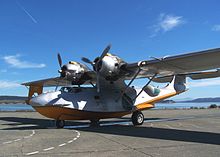 Civilian PBY Catalina, modified for aerial firefighting, arrives at the Seaplane Base, NAS Whidbey Island, Oak Harbor, Washington, 18 September 2009
Civilian PBY Catalina, modified for aerial firefighting, arrives at the Seaplane Base, NAS Whidbey Island, Oak Harbor, Washington, 18 September 2009
An Australian PBY made the first trans-Pacific flight across the South Pacific between Australia and Chile in 1946, making numerous stops at islands along the way for refueling, meals, and overnight sleep of its crew.
With the end of the war, all of the flying boat versions of the Catalina were quickly retired from the U.S. Navy, but the amphibious ones remained in service for some years. The last Catalina in U.S. service was a PBY-6A operating with a Naval Reserve squadron, which was retired from use on 3 January 1957.[2] The PBY subsequently equipped the world's smaller armed services into the late 1960s in fairly substantial numbers.
The U.S. Air Force's Strategic Air Command had PBYs (designated OA-10s) in service as scouting aircraft from 1946 through 1947.
The Brazilian Air Force flew Catalinas in naval air patrol missions against German submarines starting in 1943. The flying boats also carried out air mail deliveries. In 1948, a transport squadron was formed and equipped with PBY-5As converted to the role of amphibious transports. The 1st Air Transport Squadron (ETA-1) was based in the port city of Belem and flew Catalinas and C-47s in well-maintained condition until 1982. Catalinas were convenient for supplying military detachments scattered among the Amazon waterways. They reached places that were otherwise accessible only by long-range transport helicopters. The ETA-1 insignia was a winged turtle with the motto "Though slowly, I always get there". Today, the last Brazilian Catalina (a former RCAF one) is displayed at the Airspace Museum (MUSAL) in Rio de Janeiro.[14]
Jacques-Yves Cousteau used a PBY-6A (N101CS) to support his diving expeditions. His second son, Philippe, was killed in an accident in this aircraft that occurred on the Tagus river near Lisbon. The Catalina nosed over during a high speed taxi run undertaken to check the hull for leakage following a water landing. The aircraft turned upside down, causing the fuselage to break behind the cockpit. The wing separated from the fuselage and the left engine broke off, penetrating the captain's side of the cockpit.[15]
Paul Mantz converted an unknown number of surplus PBYs to flying yachts at his Orange County California hangar in the late 1940s and early 1950s.
Chilean navy captain Roberto Parragué in his PBY Catalina "Manu-Tara" undertook the first flight between Easter Island and the continent (from Chile) and the first flight to Tahiti; making him a national hero of France as well as of Chile. The flight was not authorized.
Of the few dozen remaining airworthy Catalinas, the majority are in use as aerial firefighting aircraft. China Airlines, the official airline of the Republic of China (Taiwan) was founded with two PBY amphibious flying boats.
Platforms are folded out and deployed from Catalinas for use in open ocean fishing and Mahi Mahi tracking in the Pacific Ocean.
Catalina affair
Main article: Catalina affairThe Catalina Affair is the name given to a Cold War incident in which a Swedish Air Force PBY Catalina was shot down by Soviet fighters over the Baltic Sea in June 1952 while investigating the disappearance of a Swedish Douglas DC-3 (later found to have been shot down by a Soviet fighter while on a SIGINT mission; found 2003 and raised 2004–2005).
Variants
- XP3Y-1
- Prototype Model 28 flying boat later re-designated XBPY-1, one built (USN Bureau No. 9459). Later fitted with a 48-foot-diameter (15 m) ring to sweep magnetic sea mines. A 550-HP Ranger engine drove a generator to produce a magnetic field.[16]
- XBPY-1
- Prototype version of the Model 28 for the United States Navy, a re-engined XP3Y-1 with two 900hp R-1830-64 engines, one built.
- PBY-1 (Model 28-1)
- Initial production variant with two 900hp R-1830-64 engines, 60 built.
- PBY-2 (Model 28-2)
- Equipment changes and improved performance, 50 built.
- PBY-3 (Model 28-3)
- Powered by two 1,000 hp R-1830-66 engines, 66 built.
- PBY-4 (Model 28-4)
- Powered by two 1,050 hp R-1830-72 engines, 33 built (including one initial as a XBPY-4 which later became the XBPY-5A).
- PBY-5 (Model 28-5)
- Either two 1200hp R-1830-82 or -92 engines and provision for extra fuel tanks, 683 built (plus one built at New Orleans), some aircraft to the RAF as the Catalina IVA and one to the United States Coast Guard. The PBY-5 was also built in the Soviet Union as the GST.
- XPBY-5
- One PBY-4 converted into an amphibian and first flown in November 1939.
- PBY-5A (Model 28-5A)
- Amphibious version of the PBY-5 with two 1,200 hp R-1830-92 engines, first batch (of 124) had one 0.3in bow gun, the remainder had two bow guns; 803 built including diversions to the United States Army Air Corps, the RAF (as the Catalina IIIA) and one to the United States Coast Guard.
- PBY-6A
- Amphibious version with two 1,200 hp R-1830-92 engines and a taller fin and rudder. Radar scanner fitted above cockpit and two 0.5 in nose guns; 175 built including 21 transferred to the Soviet Navy.
- PBY-6AG
- One PBY-6A used by the United States Coast Guard as a staff transport.
- PB2B
- Boeing built version of the PBY-5 but having a taller fin of the PBN-1, 67 built most supplied to the RAF as the Catalina VI.
- PB2S
- Boeing-Canada built PBY's for the RAF and RCAF from 1939.
- PBN
- Naval Aircraft Factory built version of the PBY-5 with major modification including a 2ft bow extension, re-designed wingtip floats and tail surfaces and a revised electrical system. A total of 155 were built for delivery to the RAF as the Catalina V although 138 were loaned to the Soviet Navy
 Canadian Vickers PBV-1A Canso A at RIAT, England in 2009. A version of the PBY-5A Catalina, this aircraft was built in 1944 for the Royal Canadian Air Force
Canadian Vickers PBV-1A Canso A at RIAT, England in 2009. A version of the PBY-5A Catalina, this aircraft was built in 1944 for the Royal Canadian Air Force
- PBV
- Canadian Vickers built version of the PBY-5A, 380 built including 150 to the Royal Canadian Air Force as the Canso-A and the rest to the USAAF as the OA-10A.
- OA-10
- United States Army Air Forces designation for PBY-5A, 105 built; 58 aircraft survivors re-designated A-10 in 1948.
- OA-10A
- USAAF designation of Canadian Vickers-built version of the PBV-1, 230 built. Survivors re-designated A-10A in 1948. Three additional aircraft from Navy in 1949 as A-10As.
- OA-10B
- USAAF designation of PBY-6A, 75 built. Re-designated A-10B in 1948.
- Catalina I
- Direct purchase aircraft for the Royal Air Force, same as the PBY-5 with six 0.303 in guns (one in bow, four in waist blisters and one aft of the hull step) and powered by two 1,200 hp R-1830-S1C3-G engines, 109 built.
- Catalina IA
- Operated by the Royal Canadian Air Force as the Canso, 14 built.
- Catalina IB
- Lend-lease PBY-5Bs for the RAF, 225 aircraft built.
- Catalina II
- Equipment changes, six built.
- Catalina IIA
- Vickers-Canada built Catalina II for the RAF, 50 built.
- Catalina IIIA
- Former US Navy PBY-5As used by the RAF on the North Atlantic Ferry Service, 12 aircraft.
- Catalina IVA
- Lend-lease PBY-5s for the RAF, 93 aircraft.
- Catalina IVB
- Lend-lease PB2B-1s for the RAF, some to the Royal Australian Air Force.
- Catalina VI
- Lend-lease PB2B-2s for the RAF, some to the RAAF.
- GST
- Soviet built version of the PBY-5 ("Gydro Samoliot Transportnyi").
Operators
Main article: List of PBY Catalina operatorsSurvivors
Main article: PBY Catalina survivorsSpecifications (PBY-5A)
Data from Encyclopedia of World Air Power[17] Jane's Fighting Aircraft of World War II[3] Handbook of Erection and Maintenance Instructions for Navy Model PBY-5 and PBY-5A Airplanes.[18] and Quest for Performance[19]
General characteristics
- Crew: 8 — pilot, co-pilot, bow turret gunner, flight mechanic, radioman, navigator and two waist gunners
- Length: 63 ft 10 7/16 in (19.46 m)
- Wingspan: 104 ft 0 in (31.70 m)
- Height: 21 ft 1 in (6.15 m)
- Wing area: 1,400 ft² (130 m²)
- Empty weight: 20,910 lb (9,485 kg)
- Max takeoff weight: 35,420 lb (16,066 kg)
- Powerplant: 2 × Pratt & Whitney R-1830-92 Twin Wasp radial engines, 1,200 hp (895 kW each) each
- Zero-lift drag coefficient: 0.0309
- Drag area: 43.26 ft² (4.02 m²)
- Aspect ratio: 7.73
Performance
- Maximum speed: 196 mph (314 km/h)
- Cruise speed: 125 mph (201 km/h)
- Range: 2,520 mi (4,030 km)
- Service ceiling: 15,800 ft (4,000 m)
- Rate of climb: 1,000 ft/min (5.1 m/s)
- Wing loading: 25.3 lb/ft² (123.6 kg/m²)
- Power/mass: 0.034 hp/lb (0.056 kW/kg)
- Lift-to-drag ratio: 11.9
Armament
- 3× .30 cal (7.62 mm) machine guns (two in nose turret, one in ventral hatch at tail)
- 2× .50 cal (12.7 mm) machine guns (one in each waist blister)
- 4,000 lb (1,814 kg) of bombs or depth charges; torpedo racks were also available
See also
- Related development
- Aircraft of comparable role, configuration and era
- Douglas P3D
- Dornier Do 24
- Kawanishi H6K
- Short Sunderland
- Related lists
- List of PBY Catalina operators
- List of flying boats
References
- Notes
- ^ It was hazardous, however; before an attack, one crew messaged, "Please inform next of kin."
- Citations
- ^ Weathered, William W. "Comment and Discussion". United States Naval Institute Proceedings, October 1968.
- ^ a b Cacutt 1989, pp. 187–194.
- ^ a b c Bridgeman 1946, p. 218.
- ^ a b Bridgeman 1946, p. 247.
- ^ "Naval Aircraft Factory PBN-1 Nomad." Aviation Enthusiast Corner. Retrieved: 18 June 2010.
- ^ Shores, Christopher et al. Bloody Shambles: Volume One: The Drift to War to the Fall of Singapore. London: Grub Street Publishing, 2002. Retrieved: 18 June 2010.
- ^ "O Brasil na WWII: ‘Arará’, o Catalina que destruiu o U-199" (in Spanish). naval.com, 8 November 2008. Retrieved: 15 February 2011.
- ^ Smith, Leonard B. "Report of Scouting and Search of PBY-5 No. AH545 "Catalina" for Bismarck 26 May, 1941". history.navy.mil. Retrieved: 18 June 2010.
- ^ Smith, Leonard B. "Bismarck: British/American Cooperation and the Destruction of the German Battleship." history.navy.mil. Retrieved: 18 June 2010.
- ^ . "Scouting and Early Attacks from Midway, 3-4 June 1942". United States Naval Historical Center, 1999. Retrieved: 18 June 2010.
- ^ Greenhous et al. 1994, p. 386.
- ^ Gaunt and Cleeworth 2000.
- ^ "The Catalinas." Qantas history. Retrieved: 26 October 2011
- ^ . "Consolidated Vultee 28 (PBY-5A/C-10A) Catalina." MUSAL. Retrieved: 18 June 2010.
- ^ "ASN Aircraft accident Consolidated PBY-6A Catalina N101CS Alverca." Aviation Safety Network. Retrieved: 30 October 2011.
- ^ Hayward, John T., VADM USN. "Comment and Discussion" United States Naval Institute Proceedings, August 1978, p. 24.
- ^ Gunston, Bill, ed. Encyclopedia of World Air Power. London: Aerospace Publishing Ltd, 1981. ISBN 0-517-53754-0.
- ^ Handbook of Erection and Maintenance Instructions for Navy Model PBY-5 and PBY-5A Airplanes.
- ^ Loftin, L.K. Jr. "Quest for Performance: The Evolution of Modern Aircraft." NASA SP-468. Retrieved: 18 June 2010.
- Bibliography
- Bridgeman, Leonard. “The Consolidated Vultee Model 28 Catalina.” Jane's Fighting Aircraft of World War II. London: Studio, 1946. ISBN 1-85170-493-0.
- Cacutt, Len, ed. “PBY Catalina: Ocean Patroller.” Great Aircraft of the World. London: Marshall Cavendish, 1989. ISBN 1-85435-250-4.
- Creed, Roscoe. PBY: The Catalina Flying Boat. Annapolis, MD: US Naval Institute Press, 1986. ISBN 0-87021-526-4.
- Crocker, Mel. Black Cats and Dumbos: WW II's Fighting PBYs. Crocker Media Expressions, 2002. ISBN 0-9712901-0-5.
- Dorny, Louis B. US Navy PBY Catalina Units of the Pacific War. Botley, Oxford, UK: Osprey Publishing, 2007. ISBN 1-84176-911-8.
- Gaunt, Coral and Robert Cleworth. Cats at War: Story of RAAF Catalinas in the Asia Pacific Theatre of War. Roseville NSW Australia: J.R. Cleworth, 2000. ISBN 978-1864085860.
- Greenhous, Brereton et al. The Crucible of War 1939-1945: The Official History of the Royal Canadian Air Force, Vol. III. Toronto: University of Toronto Press, 1994. ISBN 978-0-8020-0574-8.
- Hendrie, Andrew. Flying Cats: The Catalina Aircraft in World War II. Annapolis, MD: US Naval Institute Press, 1988. ISBN 0-87021-213-3.
- Kinzey, Bert. PBY Catalina in Detail & Scale. Carrollton, TX: Squadron/Signal Publications, Inc., 2000. ISBN 1-888974-19-2.
- Knott, Richard C. Black Cat Raiders of World War II. Annapolis, MD: US Naval Institute Press, 2000. ISBN 1-55750-471-7.
- Legg, David. Consolidated PBY Catalina: The Peacetime Record. Annapolis, MD: US Naval Institute Press, 2002. ISBN 1-55750-245-5.
- Ragnarsson, Ragnar. US Navy PBY Catalina Units of the Atlantic War. Botley, Oxford, UK: Osprey Publishing, 2006. ISBN 1-84176-910-X.
- Scarborough, William E. PBY Catalina in Action (Aircraft number 62). Carrollton, TX: Squadron/Signal Publications, Inc., 1983. ISBN 0-89747-149-0.
- Scarborough, William E. PBY Catalina - Walk Around. Carrollton, TX: Squadron/Signal Publications, Inc., 1996. ISBN 0-89747-357-4.
- Wagner, Ray. The Story of the PBY Catalina (Aero Biographies Volume 1). San Diego, CA: Flight Classics, 1972.
External links
- Catalina Aircraft Trust
- Popular Mechanics, February 1943, "Here Comes The Cats" very large and detailed article
- Picture of PH-PBY, a Consolidated PBY-5A Catalina
- PBY Catalina Foundation
- PBY Catalina International Association
- PBY Memorial Association
- Second Emergency Rescue Squadron Memorial Page
- Lt. Nathan Gordon, PBY pilot and Medal of Honor recipient
- Catalina Group of New Zealand
- Black Cats: U.S. Navy PBY Catalinas fighting in the Pacific during WWII
- (in French) Naissance d'un PBY 6A Catalina "Calypso" (Birth of PBY 6A Catalina Calypso)
- The Catalina Society (Plane Sailing) UK
- Catalina images
- A film clip "Story of the Black Cats", a U.S. Navy film is available for free download at the Internet Archive [more]
Aircraft produced by Consolidated Aircraft Manufacturer designation By role USN/USMC patrol aircraft designations 1923-1962 Patrol HallKeystonePN • P2N • P4N
LockheedPOSikorskyPS • P2S
LockheedPatrol Bomber XPBB • PB2B
PBNLockheedSikorskyPBSVickers CanadaPBVPatrol Torpedo Bomber HallUSAAC/USAAF observation aircraft Observation O-1 • O-2 • XO-3 • XO-4 • O-5 • O-6 • O-7 • O-8 • O-9 • XO-10 • O-11 • O-12 • O-14 • XO-14 • XO-15 • XO-16 • O-17 • XO-18 • O-19 • YO-20 • XO-21 • O-22 • YO-23 • O-24 • O-25 • Y1O-26 • Y1O-27 • O-28 • O-29 • O-30 • O-31 • O-32 • Y1O-33 • O-34 • O-35 • XO-36 • O-37 • O-38 • O-39 • O-40 • Y1O-41 • O-42 • O-43 • XO-44 • O-45 • O-46 • O-47 • XO-48 • O-49 • YO-50 • YO-51 • O-52 • O-53 • YO-54 • YO-55 • O-56 • O-57 • O-58 • O-59 • O-60 • XO-61 • O-62 • XO-63
Observation Amphibian Swedish Air Force military aircraft designations 1940–present B/S/T/Tp 16 - Sk 16 • B/S 17 • B/S/T 18 • J 19 • J 20 • A/J 21 • J/S 22 • J 23 • B/J 24 - Tp 24 • Sk 25 • Sk 26 - B/S 26 - J/S 26 • J 27 • A/J/Sk 28 • A/J/S 29 • J 30 • S 31 • A/J/S 32 • J 33 • J 34 • J/S/Sk 35 • A 36 • AJ/JA 37 • A/Sk 38 • JAS 39 • Tp 45 • Tp 46 • Tp 47 • Sk 50 • Fpl 51 • Tp 52 • Tp 53 • Fpl 54 - Tp 54 • Tp 55 • Sk 60 • Sk/Fpl 61 • Tp 78 • Tp 79 • Tp 80 • Tp 81 • Tp 82 • Tp 83 • Tp 84 • Tp 85 • Tp 86 • Tp 87 • Tp 88 • Tp 89 • Tp 91 • Tp 100 • Tp 101 • Tp 102 • Tp 103
Canadian Vickers aircraft models Canadian Vickers Produced under license Vickers Viking IV · Supermarine Stranraer · Avro 504N · Avro 552 · Bellanca Pacemaker · Curtiss HS-3L · Fairchild FC-2 · Fokker Super Universal · Northrop Delta · Canadian Vickers PBV-1 Canso
See also: Canadair · Vickers Lists relating to aviation General Aircraft (manufacturers) · Aircraft engines (manufacturers) · Airlines (defunct) · Airports · Civil authorities · Museums · Registration prefixes · Rotorcraft (manufacturers) · TimelineMilitary Accidents/incidents Records Categories:- Seaplanes and flying boats
- Amphibious aircraft
- United States patrol aircraft 1930–1939
- World War II patrol aircraft of the United States
- United States Coast Guard Aviation
- Twin-engined aircraft
- Aerial firefighting
- Consolidated aircraft
- Naval Aircraft Factory aircraft
Wikimedia Foundation. 2010.

